Flexible Hinge Palette
Maurin; Denis ; et al.
U.S. patent application number 16/162995 was filed with the patent office on 2019-04-18 for flexible hinge palette. This patent application is currently assigned to HCT GROUP HOLDINGS LIMITED. The applicant listed for this patent is HCT GROUP HOLDINGS LIMITED. Invention is credited to Thomas Chun, Denis Maurin, Jeremy Wilson.
| Application Number | 20190110578 16/162995 |
| Document ID | / |
| Family ID | 66096748 |
| Filed Date | 2019-04-18 |

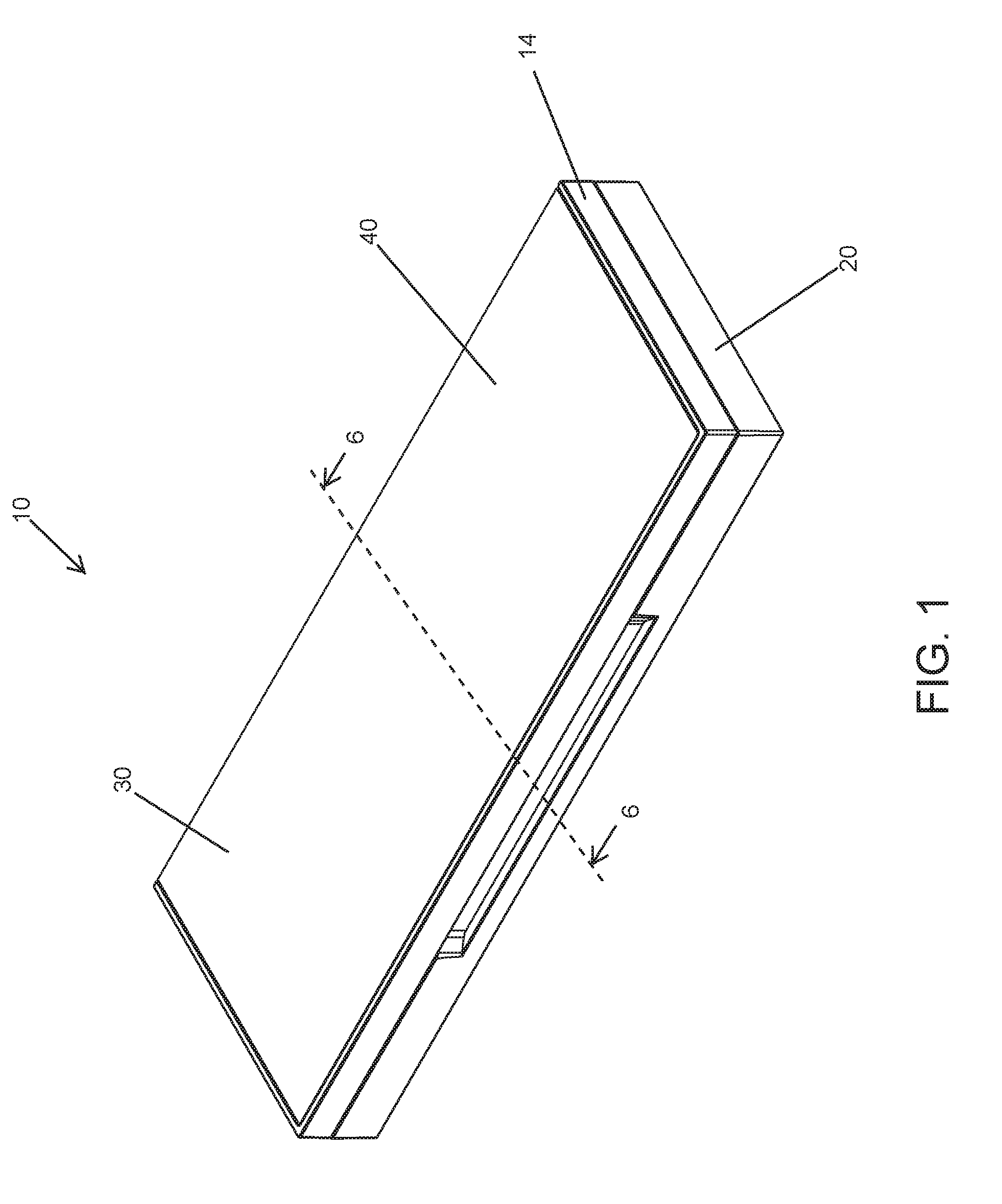
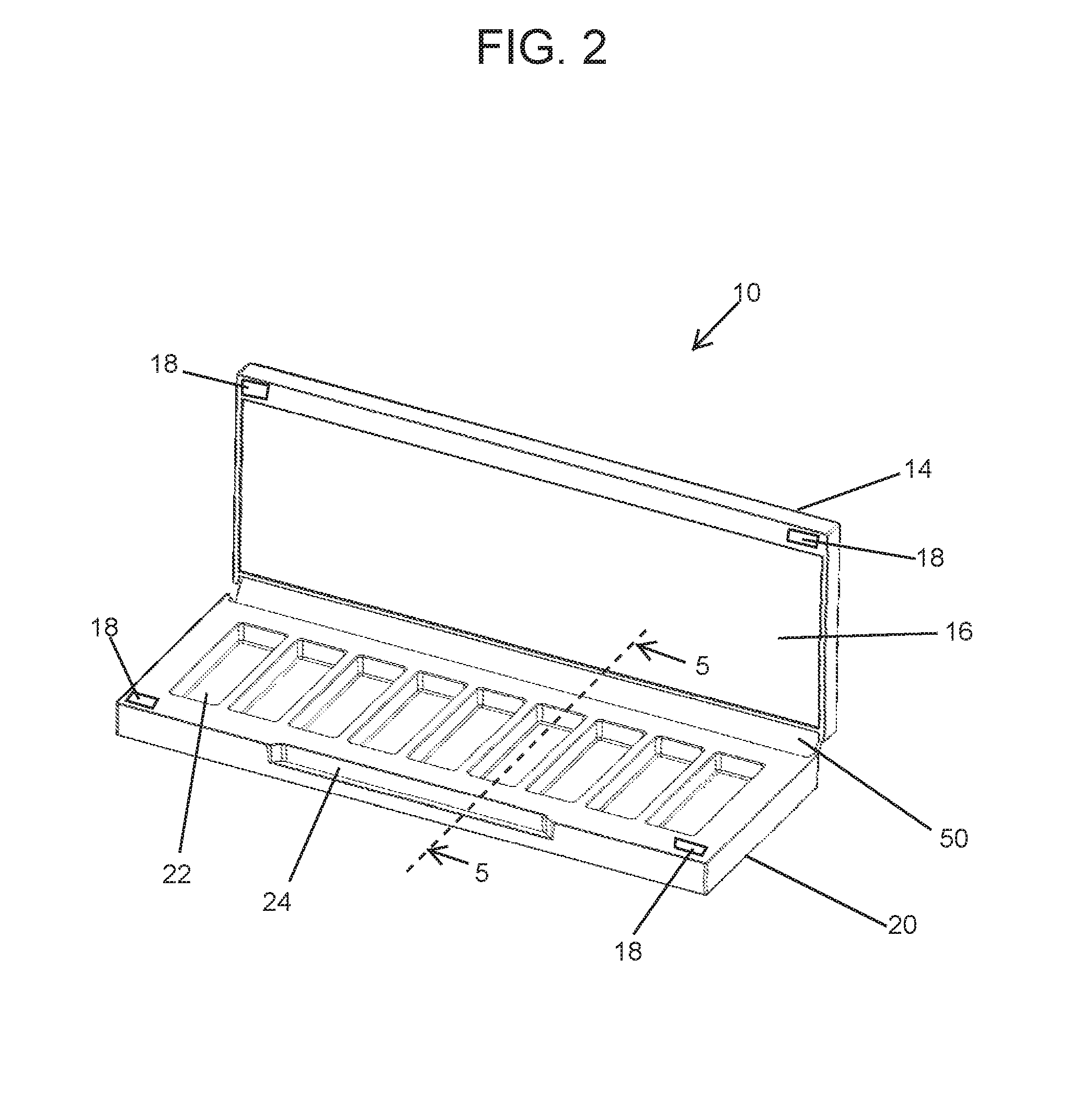
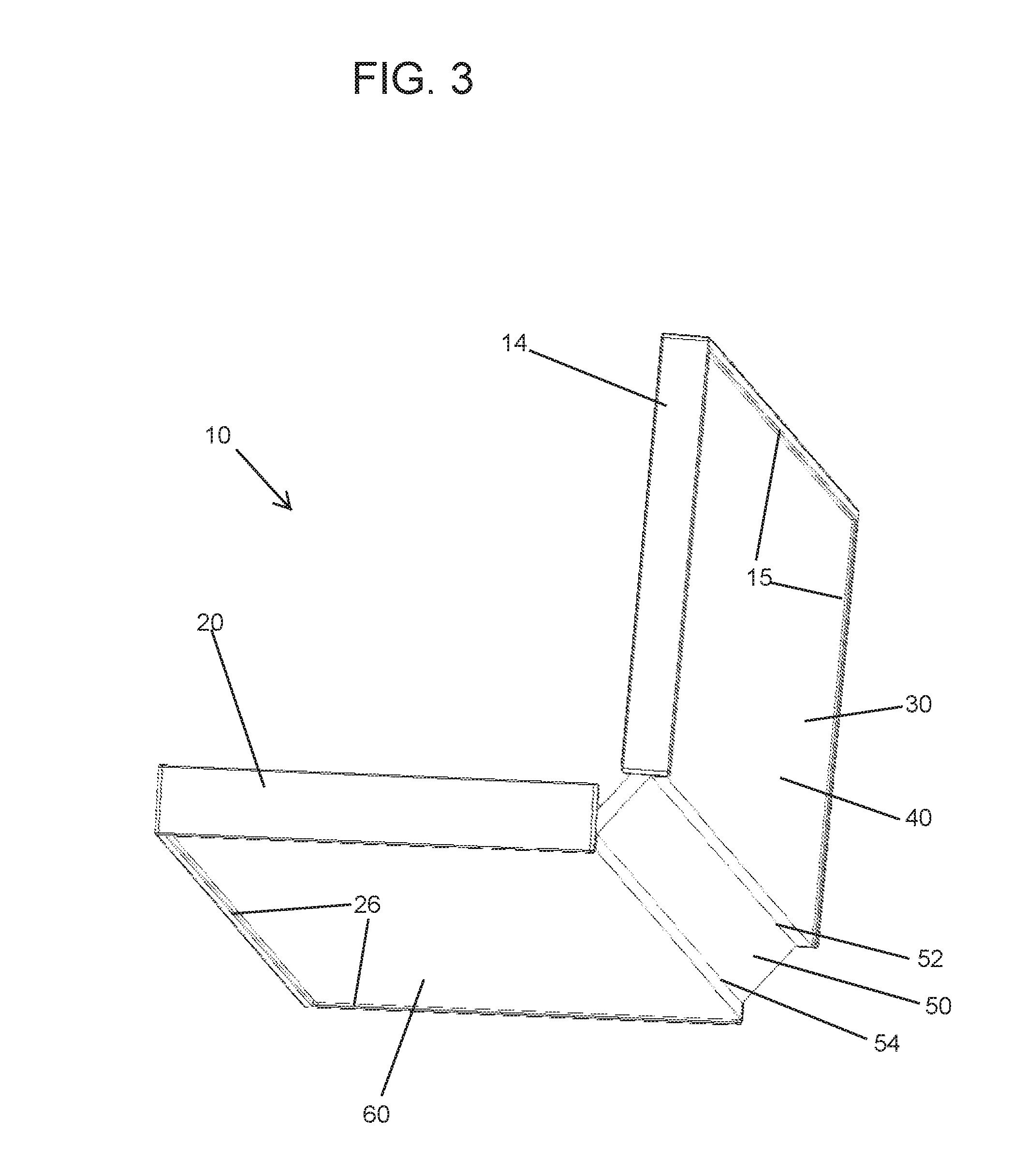

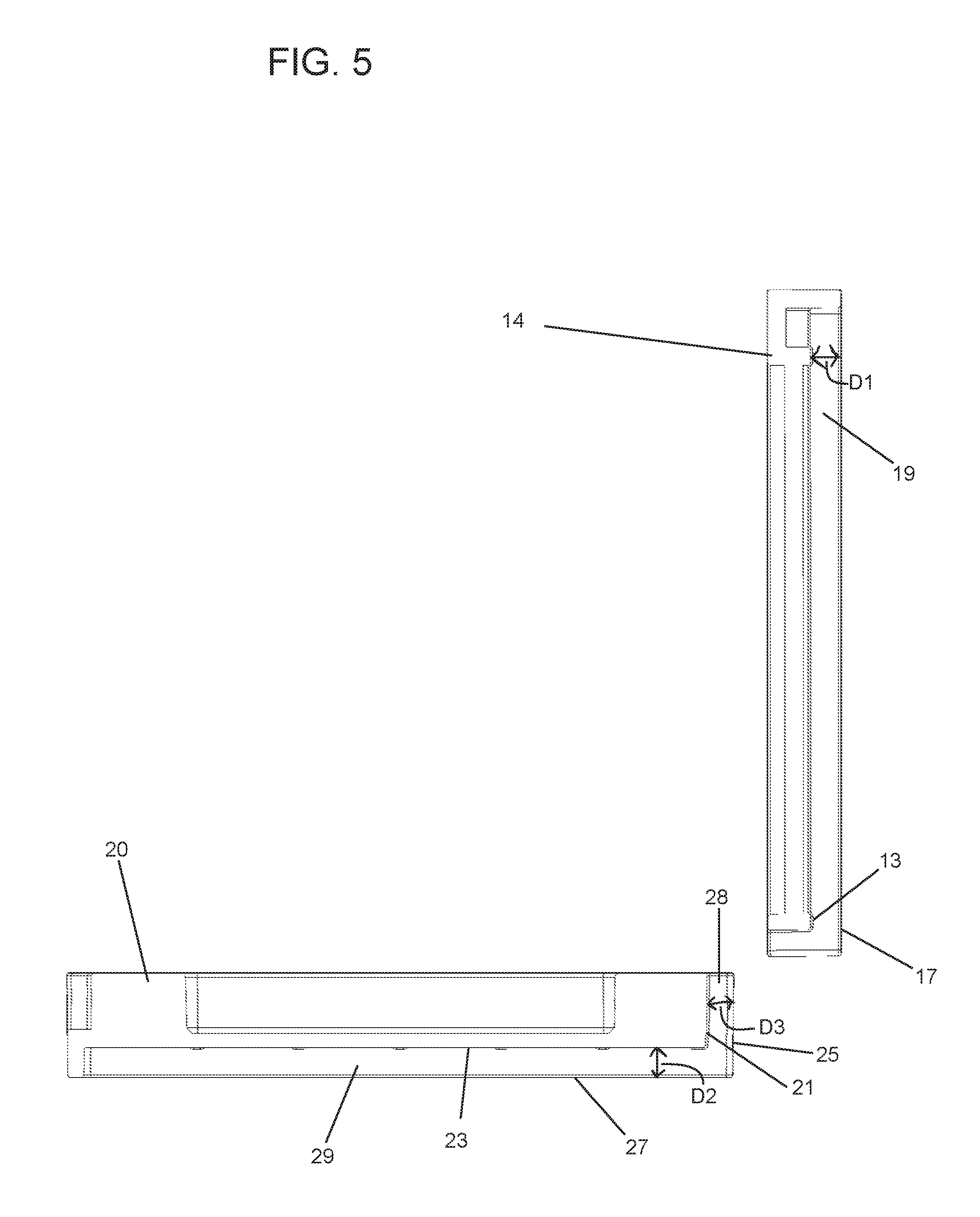


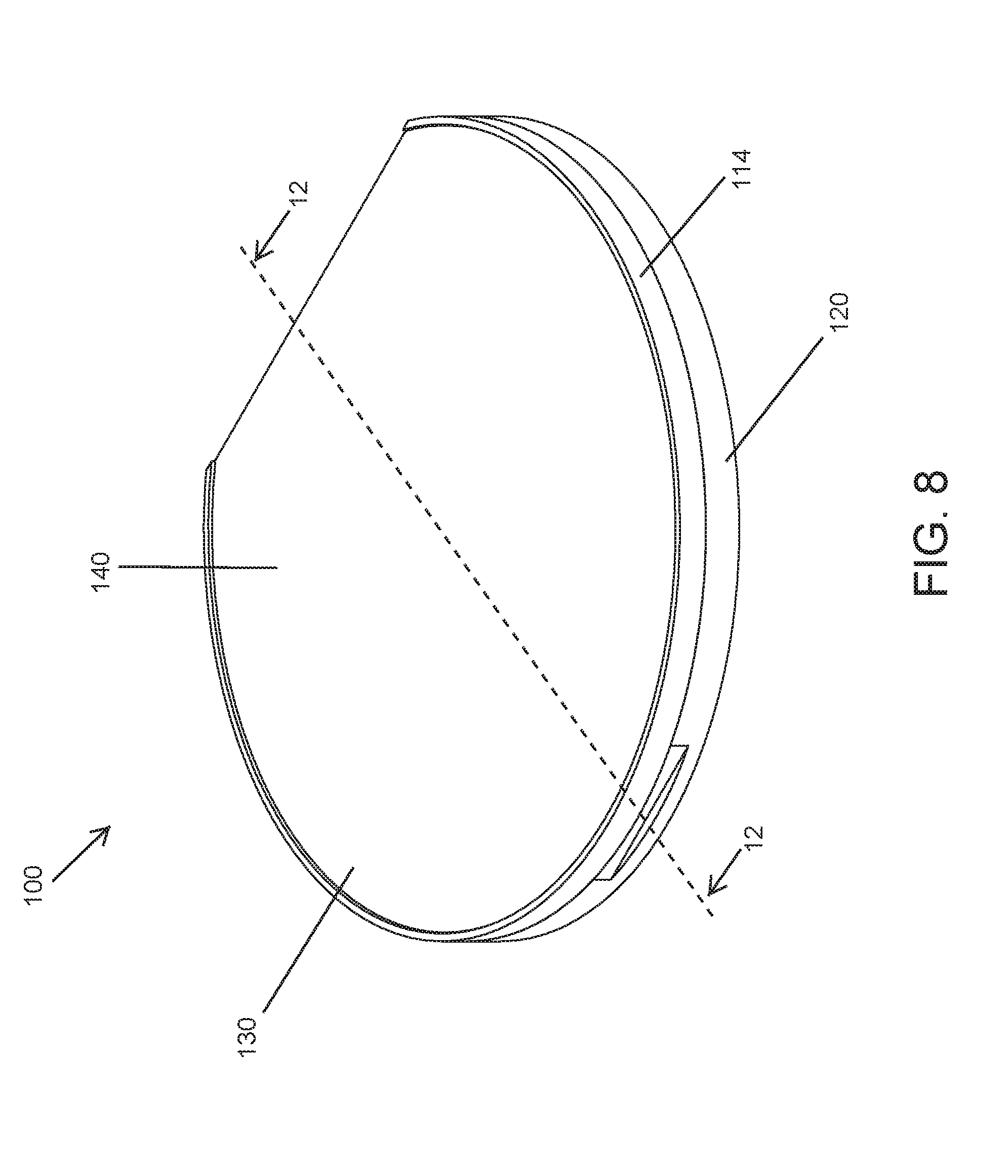

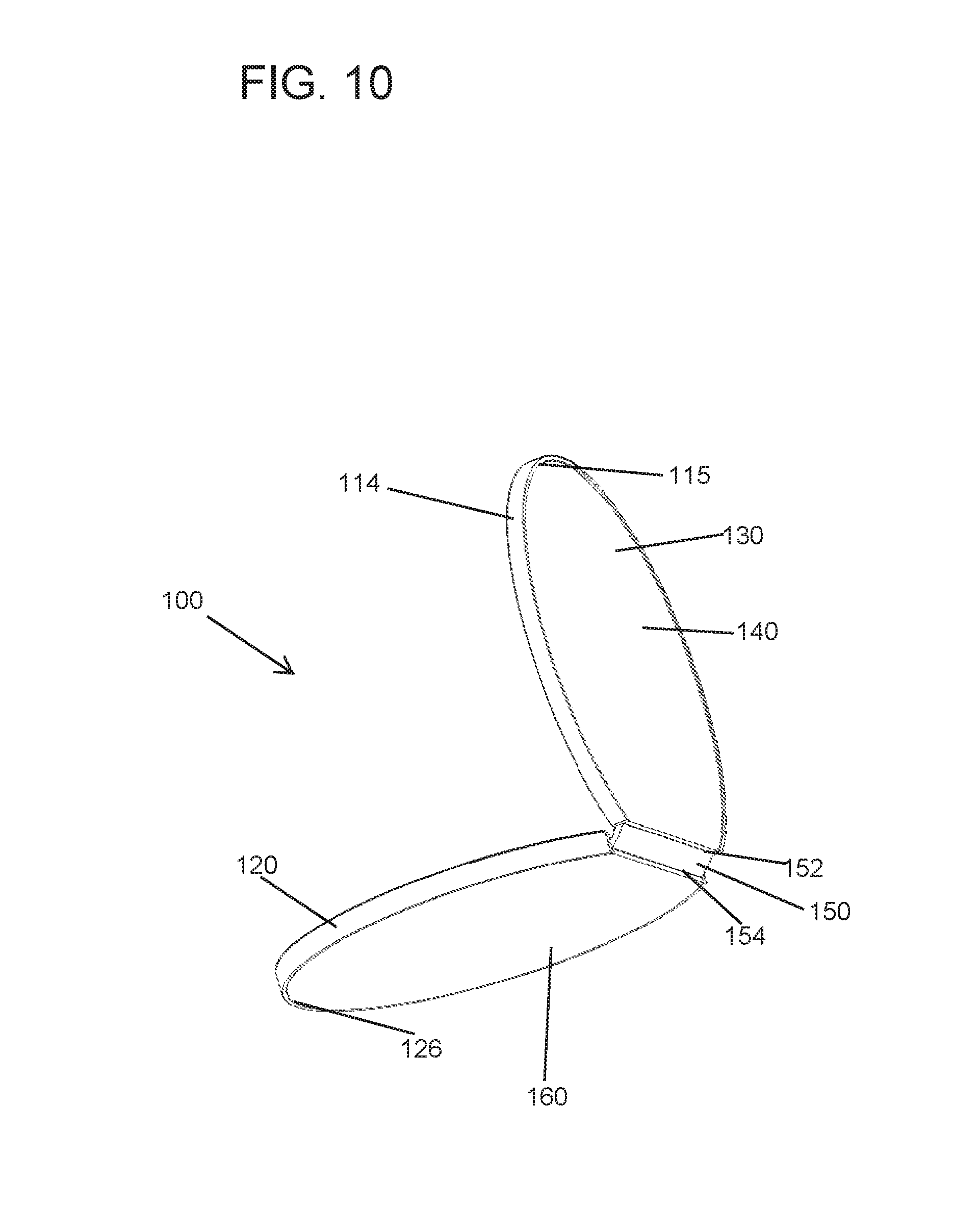

View All Diagrams
| United States Patent Application | 20190110578 |
| Kind Code | A1 |
| Maurin; Denis ; et al. | April 18, 2019 |
FLEXIBLE HINGE PALETTE
Abstract
A cosmetic container includes a base, a lid, and a cover. The base defines at least one well for holding a cosmetic, and a base cavity on an opposite surface as the well, and the lid defines a lid cavity. The cover couples the lid to the base, the cover includes a top portion disposed within the lid cavity and a bottom portion disposed within the base cavity. The cover forms a hinge allowing the lid to rotate relative to the base from a closed position in which the first surface of the lid is disposed over the well in the base, to an open position in which the well is exposed. The cover has a flexibility different from the base and lid.
| Inventors: | Maurin; Denis; (Los Angeles, CA) ; Chun; Thomas; (Buena Park, CA) ; Wilson; Jeremy; (Los Angeles, CA) | ||||||||||
| Applicant: |
|
||||||||||
|---|---|---|---|---|---|---|---|---|---|---|---|
| Assignee: | HCT GROUP HOLDINGS LIMITED CENTRAL CN |
||||||||||
| Family ID: | 66096748 | ||||||||||
| Appl. No.: | 16/162995 | ||||||||||
| Filed: | October 17, 2018 |
Related U.S. Patent Documents
| Application Number | Filing Date | Patent Number | ||
|---|---|---|---|---|
| 62573965 | Oct 18, 2017 | |||
| Current U.S. Class: | 1/1 |
| Current CPC Class: | A45D 40/22 20130101; A45D 33/008 20130101; A45D 40/222 20130101; A45D 2040/225 20130101; A45D 40/24 20130101; A45D 40/221 20130101; A45D 2040/224 20130101 |
| International Class: | A45D 40/22 20060101 A45D040/22 |
Claims
1. A cosmetic container comprising: a base having an upper surface and a lower surface opposite the upper surface, the upper surface defining at least one well for holding a cosmetic, the lower surface defining a base cavity; a lid having a first surface and a second surface opposite the first surface, the second surface defining a lid cavity; and a cover coupled to the base and the lid and disposed within the base cavity and the lid cavity, the cover defining outer surfaces of the base cavity and the lid cavity, the cover forming a hinge allowing the lid to rotate relative to the base from a closed position in which the first surface of the lid is disposed over the well in the base, to an open position in which the well is exposed, the cover formed from a single piece of material, the cover having a flexibility different from the base and lid.
2. The cosmetic container of claim 1, wherein the hinge includes first and second spaced apart creases.
3. The cosmetic container of claim 1, wherein the cover alone forms the hinge.
4. The cosmetic container of claim 1, wherein at least one of the base cavity and lid cavity has a depth larger than a thickness of the cover such that a portion of the base and/or lid projects outward perpendicularly beyond an outer surface of the cover, defining an overhang.
5. The cosmetic container of claim 4, wherein the base cavity depth is larger than the thickness of the cover and the lid cavity depth is the same as or smaller than the thickness of the cover.
6. The cosmetic container of claim 1, wherein the hinge is configured to allow the lid to move through 360 degrees of rotation relative to the base.
7. The cosmetic container of claim 1, wherein the cover is cardboard.
8. The cosmetic container of claim 1, wherein the flexibility of the cover is greater than a flexibility of the base and/or lid.
9. The cosmetic container of claim 1, further comprising at least one securing element that reversibly secures the lid to the base in the closed position.
10. The cosmetic container of claim 9, wherein the securing element includes at least one magnet positioned on the lid and at least one magnet positioned on the base.
11. A cosmetic container comprising: a base having an upper surface and a lower surface opposite the upper surface, the upper surface defining at least one well for holding a cosmetic, the lower surface defining a base cavity; a lid having a first surface and a second surface opposite the first surface, the second surface defining a lid cavity; and a cover coupling the lid to the base, the cover including a top portion disposed within the lid cavity and a bottom portion disposed within the base cavity, the cover forming a hinge allowing the lid to rotate relative to the base from a closed position in which the first surface of the lid is disposed over the well in the base, to an open position in which the well is exposed, the cover having a flexibility different from the base and lid.
12. The cosmetic container of claim 11, wherein the cover is formed as a single piece.
13. The cosmetic container of claim 11, wherein the hinge includes a first crease disposed adjacent the lid and a second crease disposed adjacent the base.
14. The cosmetic container of claim 11, wherein the base cavity has a depth larger than a thickness of the bottom portion of the cover such that a portion of the base projects outward perpendicularly beyond an outer surface of the bottom portion of the cover, defining a base overhang.
15. The cosmetic container of claim 14, wherein the lid cavity has a depth larger than a thickness of the top portion of the cover such that a portion of the lid projects outward perpendicularly beyond an outer surface of the top portion of the cover, defining a lid overhang.
16. The cosmetic container of claim 14, wherein the base overhang or lid overhang extends around all sides of the base or lid except the hinge.
17. The cosmetic container of claim 14, wherein the lid cavity has a depth that is the same as or smaller than a thickness of the top portion of the cover.
18. The cosmetic container of claim 11, wherein the hinge is configured to allow the lid to move through 360 degrees of rotation relative to the base.
19. The cosmetic container of claim 11, wherein the cover is cardboard.
20. The cosmetic container of claim 11, wherein the flexibility of the cover is greater than a flexibility of the base and/or lid.
Description
CROSS REFERENCE TO RELATED APPLICATIONS
[0001] The present application claims the benefit of and priority to U.S. Provisional Patent App. No. 62/573,965, filed Oct. 18, 2017 and titled FLEXIBLE HINGE PALETTE, the disclosure of which is incorporated herein by reference.
BACKGROUND
[0002] Numerous types of containers such as compacts and palettes are available for cosmetic products. Such containers hold products in a useable form such as powder, cream, paste, etc., with various designs to allow a user access to the products. New and alternative approaches to such devices are desired.
SUMMARY
[0003] This disclosure provides designs, material, and use alternatives for cosmetic packaging.
[0004] According to one example of the present disclosure, a cosmetic container comprises a base having an upper surface and a lower surface opposite the upper surface, the upper surface defining at least one well for holding a cosmetic, the lower surface defining a base cavity, a lid having a first surface and a second surface opposite the first surface, the second surface defining a lid cavity, and a cover coupled to the base and the lid and disposed within the base cavity and the lid cavity, the cover defining outer surfaces of the base cavity and the lid cavity, the cover forming a hinge allowing the lid to rotate relative to the base from a closed position in which the first surface of the lid is disposed over the well in the base, to an open position in which the well is exposed, the cover formed from a single piece of material, the cover having a flexibility different from the base and lid.
[0005] Alternatively, or additionally, in another example, the hinge includes first and second spaced apart creases.
[0006] Alternatively, or additionally, in another example, the cover alone forms the hinge.
[0007] Alternatively, or additionally, in another example, at least one of the base cavity and lid cavity has a depth larger than a thickness of the cover such that a portion of the base and/or lid projects outward perpendicularly beyond an outer surface of the cover, defining an overhang.
[0008] Alternatively, or additionally, in another example, the base cavity depth is larger than the thickness of the cover and the lid cavity depth is the same as or smaller than the thickness of the cover.
[0009] Alternatively, or additionally, in another example, the hinge is configured to allow the lid to move through 360 degrees of rotation relative to the base.
[0010] Alternatively, or additionally, in another example, the cover is cardboard.
[0011] Alternatively, or additionally, in another example, the flexibility of the cover is greater than a flexibility of the base and/or lid.
[0012] Alternatively, or additionally, in another example, the cosmetic container further comprises at least one securing element that reversibly secures the lid to the base in the closed position.
[0013] Alternatively, or additionally, in another example, the securing element includes at least one magnet positioned on the lid and at least one magnet positioned on the base.
[0014] Alternatively, or additionally, in another example,
[0015] According to another example, a cosmetic container comprises a base having an upper surface and a lower surface opposite the upper surface, the upper surface defining at least one well for holding a cosmetic, the lower surface defining a base cavity, a lid having a first surface and a second surface opposite the first surface, the second surface defining a lid cavity, and a cover coupling the lid to the base, the cover including a top portion disposed within the lid cavity and a bottom portion disposed within the base cavity, the cover forming a hinge allowing the lid to rotate relative to the base from a closed position in which the first surface of the lid is disposed over the well in the base, to an open position in which the well is exposed, the cover having a flexibility different from the base and lid.
[0016] Alternatively, or additionally, in another example, the cover is formed as a single piece.
[0017] Alternatively, or additionally, in another example, the hinge includes a first crease disposed adjacent the lid and a second crease disposed adjacent the base.
[0018] Alternatively, or additionally, in another example, the base cavity has a depth larger than a thickness of the bottom portion of the cover such that a portion of the base projects outward perpendicularly beyond an outer surface of the bottom portion of the cover, defining a base overhang.
[0019] Alternatively, or additionally, in another example, the lid cavity has a depth larger than a thickness of the top portion of the cover such that a portion of the lid projects outward perpendicularly beyond an outer surface of the top portion of the cover, defining a lid overhang.
[0020] Alternatively, or additionally, in another example, the base overhang or lid overhang extends around all sides of the base or lid except the hinge.
[0021] Alternatively, or additionally, in another example, the lid cavity has a depth that is the same as or smaller than a thickness of the top portion of the cover.
[0022] Alternatively, or additionally, in another example, the hinge is configured to allow the lid to move through 360 degrees of rotation relative to the base.
[0023] Alternatively, or additionally, in another example, the cover is cardboard.
[0024] Alternatively, or additionally, in another example, the flexibility of the cover is greater than a flexibility of the base and/or lid.
[0025] The above summary of some example embodiments is not intended to describe each disclosed embodiment or every implementation of the present disclosure. The Figures, and Detailed Description, which follow, more particularly exemplify these embodiments.
BRIEF DESCRIPTION OF THE DRAWINGS
[0026] The foregoing and other aspects of the present invention are best understood from the following detailed description when read in connection with the accompanying drawings. In the drawings, which are not necessarily drawn to scale, like numerals may describe similar components in different views. Like numerals having different letter suffixes may represent different instances of similar components. The drawings illustrate generally, by way of example, but not by way of limitation, various embodiments discussed in the present document. Included in the drawings are the following Figures:
[0027] FIG. 1 is a perspective front view of an illustrative cosmetic container;
[0028] FIG. 2 is a perspective front view of the cosmetic container of FIG. 1 with the lid in an open configuration;
[0029] FIG. 3 is a perspective rear view of the cosmetic container of FIG. 2;
[0030] FIG. 4 is a perspective exploded view of the elements of the cosmetic container of FIG. 2;
[0031] FIG. 5 is a side cross sectional view of just the lid and base of the cosmetic container taken along line 5-5 of FIG. 2;
[0032] FIG. 6 is a side cross sectional view of the cosmetic container of FIG. 1 taken along line 6-6;
[0033] FIG. 7 is a side cross sectional view of the cosmetic container of FIG. 1 with the lid bent back beneath the base;
[0034] FIG. 8 is a perspective front view of another illustrative cosmetic container;
[0035] FIG. 9 is a perspective front view of the cosmetic container of FIG. 8 with the lid in an open configuration;
[0036] FIG. 10 is a perspective rear view of the cosmetic container of FIG. 9;
[0037] FIG. 11 is a perspective exploded view of the elements of the cosmetic container of FIG. 9; and
[0038] FIG. 12 is a side cross sectional view taken along line 12-12 in FIG. 8.
DETAILED DESCRIPTION
[0039] The following description should be read with reference to the drawings wherein like reference numerals indicate like elements throughout the several views. The description and drawings show several embodiments which are meant to be illustrative in nature.
[0040] For convenience, the present disclosure may be described using relative terms including, for example, left, right, top, bottom, front, back, upper, lower, up, and down, as well as others. It is to be understood that these terms are merely used for illustrative purposes and are not meant to be limiting in any manner.
[0041] FIG. 1 is a front perspective view of an exemplary palette or cosmetic container 10 in a closed configuration. As shown in FIG. 1, the cosmetic container 10 may include a lid 14 and a base 20. The lid 14 may include a top portion 40 of a cover 30. The cosmetic container 10 may have a generally rectangular shape, as illustrated in FIG. 1. However, the cosmetic container 10 may take any shaped desired, including, but not limited to, circular or semi-circular, as shown in FIG. 8, square, triangular, half-ovoid, polygonal, etc.
[0042] In some examples, the lid 14 and base 20 of the cosmetic container 10 and/or the various components thereof may be made from a rigid material (e.g., plastic such as acrylonitrile butadiene styrene, thermoplastics, other polymers, glass, hard rubber, metal, alloy, wood). Other examples may, however, include containers 10 made from a flexible or semi-rigid material, such as plastic.
[0043] The lid 14 may be coupled to the base 20 in an orientation to cover the base 20. The lid 14 and base 20 may have identical or substantially the same outer dimensions to provide a uniform outer surface. In other examples, the lid 14 may have outer dimensions larger or smaller than the base 20. The lid 14 may be pivotably coupled to the base 20 at a hinge 50, as shown in FIG. 2. For example, the lid 14 can be rotated open to expose a mirror 16 affixed to the underside of the lid and a plurality of wells 22 disposed in the base 20. The lid 14 may be selectively and reversibly coupled to the base 20 with a securing element such as a magnetic closure, snap fit, friction fit, or other suitable coupling mechanism. In some examples, the securing element includes one or more magnet 18 as shown in FIG. 2. The base 20 may include a cut-out portion or recess 24 on the front to provide a space for the user to grasp the lid 14 and rotate the lid 14 away from the base 20.
[0044] The wells 22 may receive fill pucks of cosmetic product (not shown). The fill pucks may be fixed to the wells 22 or the fill pucks may be removable, replaceable and/or interchangeable, as desired. The fill pucks may be configured to receive a cosmetic product, such as, but not limited to loose powders (e.g., for eye, cheek, face, and the like), pressed powders (e.g., for eye, cheek, face, and the like), creams (e.g., skincare, eye, foundation, and the like), sunscreen, hot pour products (e.g., lipsticks, glosses, and the like), touchup, spot cover, baked powders, pastes, moisturizers, hair creams, gels, serums, and the like. Alternatively, the cosmetic product may be deposited directly into the wells 22.
[0045] The wells 22 may have various sizes and shapes. For example, as shown in FIG. 2, the container 10 contains nine wells 22 of the same size and shape. It is contemplated that the wells 22 may have differing quantities, sizes and/or shapes. For example, a single well 22 may fill the entire base 20, or multiple wells 22 of varying sizes and/or shapes may be provided. The cosmetic container 10 may be provided with a large array of well sizes and placement configurations. In some cases, one or more wells 22 may be free from a fill puck to allow for the placement and/or retention of a cosmetic implement. Some illustrative implements may include but are not limited to an applicator with a handle, an applicator without a handle, a stencil (e.g., a brow stencil), tweezers, a brush with or without a handle, a sponge with or without a handle, a pencil, a vial, a lipstick, etc.
[0046] FIG. 3 shows the bottom and rear faces of the container 10, which may be defined by the cover 30. The cover may include a top portion 40, a bottom portion 60, and a hinge 50. The cover 30 may be formed as a single piece element, as shown in FIG. 4, with an upper fold line, groove, thinned region, score line, or crease 52 separating the top portion 40 and hinge 50, and a lower fold line, groove, thinned region, score line, or crease 54 separating the hinge 50 and bottom portion 60. The upper and lower creases 52, 54 act as living hinges and permit rotation or flexion at these locations, allowing the top portion 40 and bottom portion 60 portions of the cover 30 to be moved from a substantially parallel orientation when the container 10 is closed, as shown in FIG. 1, to an angled orientation when the lid 14 is opened, as shown in FIGS. 2-3. In some examples, the entire cover 30, including the top portion 40, bottom portion 60, and hinge 50, is formed from a single piece of material, such as solid cardboard (as opposed to corrugated cardboard). The cardboard provides a low cost, lightweight material that is easy to decorate. Other materials such as thin plastic, wood, fabric, leather, vinyl, or polyurethane (a.k.a. "pleather", "faux leather", or "vegan leather") may also be used to make the cover 30. The cover 30, including one or more of the top portion 40, hinge 50, and bottom portion 60, may be printed and/or textured on the outer surface, providing a design visible when the container is closed.
[0047] In some examples, the upper and lower creases 52, 54 may allow the lid 14 to be moved through substantially 360 degrees of rotation, from a closed configuration as shown in FIGS. 1 and 6, through a partially open configuration as shown in FIG. 3, to a configuration shown in FIG. 7, with the lid 14 rotated underneath the base 20. The lid-on-the-bottom configuration shown in FIG. 7 may provide an alternative way for the user to hold the container 10 in one hand with the lid 14 out of the way when the mirror 16 is not needed.
[0048] The cover 30 may be formed as a separate piece from the lid 14 and base 20. The cover 30 may be attached to the lid 14 and base 20 by adhesive, soldering, heat fusing, or any other suitable joining method. In some examples, the cover 30 is formed from a material different from the lid 14 and base 20. For example, the cover 30 may be cardboard and the lid 14 and base 20 may be plastic. In other examples, the cover 30, lid 14, and base 20 may all be formed from plastic, with the cover 30 having a different flexibility than the lid 14 and/or base 20. In one example, the cover 30 may be formed from a plastic having a greater flexibility than the plastic used to form the lid 14 and base 20. In other examples, all of the cover 30, lid 14, and base 20 may be formed from the same plastic, with the thickness of the cover 30 being significantly less than the thickness of the lid 14 and base 20, providing a greater flexibility to the cover 30 as compared to the lid 14 and base 20. Alternatively, in some examples, the cover 30, lid 14, and base 20 may all be made of the same plastic and have thicknesses resulting in the same flexibility, with the creases 52, 54 alone providing greater flexibility to the cover 30 as compared to the lid 14 and base 20. In still other examples, each of the cover 30, lid 14, and base 20 may be formed from plastics having different flexibilities, with the cover 30 having the greatest flexibility.
[0049] The lid 14 and base 20 have open backs defining a lid cavity 19 and a base cavity 29, respectively, as shown in FIG. 4, configured to receive the cover 30. This configuration results in only the cover 30 defining the lower surface of the base 20 and the outer surface of the lid 14. As seen in FIG. 6, the outer surfaces of the top, rear, and bottom of the container 10 are formed by the cover 30 alone, while the front is formed by the base 20 and lid 14. The left and right sides are formed by the base 20 and lid 14.
[0050] In some examples, the lid cavity 19 may have a depth D1 such that once the top portion 40 of the cover 30 is received therein, a portion of the lid 14 extends beyond the cover 30, defining a lid overhang 15. Similarly, the base cavity 29 may have a depth D2 such that once the bottom portion 60 of the cover 30 is received therein, a portion of the base 20 extends beyond the cover 30, defining a base overhang 26. As shown in FIG. 3 the lid overhang 15 and the base overhang 26 may extend around all three sides of the cover 30 that is in contact with the lid 14 and base 20, respectively.
[0051] The lid cavity 19 may have a depth D1 measured between a lid internal surface 13 and a lid outer extremity 17, as shown in FIG. 5. Similarly, the base cavity 29 may have a depth D2 measured between a base internal surface 23 and a base outer extremity 27. The base 20 may also have a rear cavity 28 with a depth D3 measured between a rear internal surface 21 and a rear outer extremity 25. D1, D2, and D3 may be the same as, smaller than, or larger than the thickness of the top portion 40, bottom portion 60, and hinge 50, respectively. In some embodiments, D1 and D2 may be larger than the thicknesses of the top portion 40 and bottom portion 60 of the cover 30, respectively, such that when the cover 30 is disposed within the lid cavity 19 and base cavity 29, a portion of the lid 14 and base 20 project outwardly and substantially perpendicular beyond the outer surface of the cover 30, defining a lid overhang 15 and base overhang 26, respectively. The lid overhang 15 and base overhang 26 may provide the advantage of allowing the container 10 to sit on the base 20 and/or lid 14 instead of on the cover 30. In examples where the cover 30 is made from cardboard, the lid overhang 15 and/or base overhang 26 may allow the container 10 to be placed on a wet or damp surface without the cardboard cover 30 contacting the wet or damp surface.
[0052] In the example shown in FIG. 6, the depth D2 of the base cavity 29 is larger than the thickness of the bottom portion 60 of the cover 30, revealing the base overhang 26. In other examples, only the base cavity 29 has a depth D2 larger than the thickness of the bottom portion 60 of the cover 30, creating a base overhang 26, while the lid cavity 19 may have a depth D1 that is the same as or smaller than the thickness of the top portion 40 of the cover. This configuration provides a smooth surface across the entirety of the top of the container 10. In the example shown in FIG. 6, the depth D3 of the rear cavity 28 is the same as or less than the thickness of the hinge 50.
[0053] The thickness of the cover 30 may be uniform across the entirety of the cover, including the top portion 40, bottom portion 60, and hinge 50. In other examples, one or more of the top portion 40, bottom portion 60, and hinge 50 may have a different thickness than the remaining portions. It will be understood that the thickness of the cover 30 relative to the depth D1 refers to the thickness of the top portion 40 of the cover, the thickness of the cover 30 relative to the depth D2 refers to the thickness of the bottom portion 60 of the cover, and the thickness of the cover 30 relative to the depth D3 refers to the thickness of the hinge 50 portion of the cover. In some examples, the top portion 40, bottom portion 60 and hinge 50 are each substantially planar such that the thickness of each portion is uniform. In other examples, one or more of the top portion 40, bottom portion 60, and hinge 50 may have raised and/or depressed regions, such as with embossing or etching. This may provide a design, particularly on the top portion 40 and/or hinge 50. In examples where the thickness of the cover is not uniform, the measured thickness relative to the depth D1, D2, and D3 is the greatest thickness across the top portion 40, bottom portion 60, and hinge 50.
[0054] FIG. 8 is a front perspective view of another exemplary palette or cosmetic container 100 in a closed configuration. As shown in FIG. 8, the cosmetic container 100 may include a lid 114 and a base 120. The lid 114 may include a top portion 140 of a cover 130. The cosmetic container 100 shown in FIG. 8 has a generally circular shape. As with the cosmetic container 10 shown in FIGS. 1-7, the lid 114 and base 120 of the cosmetic container 100 and/or the various components thereof may be made from a rigid material (e.g., acrylonitrile butadiene styrene, thermoplastics, other polymers, glass, metal, alloy, wood, and the like). Other examples may, however, include containers 100 made from a flexible or semi-rigid material, such as plastic.
[0055] The lid 114 may be coupled to the base 120 in an orientation to cover the base 120. The lid 114 and base 120 may have identical or substantially the same outer dimensions to provide a uniform outer surface. In other examples, the lid 114 may have outer dimensions larger or smaller than the base 120. The lid 114 may be pivotably coupled to the base 120 at a hinge 150, as shown in FIG. 9. For example, the lid 114 can be rotated open to expose a mirror 116 affixed to the underside of the lid and a plurality of wells 122 disposed in the base 120. The lid 114 may be selectively coupled to the base 120 with a magnetic closure such as with one or more magnet 118 as shown in FIG. 9, or with a snap fit, friction fit, or other suitable coupling mechanism. The base 120 may include a cut-out portion or recess 124 on the front to provide a space for the user to grasp the lid 114 and rotate the lid 114 away from the base 120. The wells 122 may receive fill pucks of cosmetic product (not shown). The fill pucks may be fixed to the wells 122 or the fill pucks may be removable, replaceable and/or interchangeable, as desired. The fill pucks may be configured to receive a cosmetic product, such as, but not limited to loose powders (e.g., for eye, cheek, face, and the like), pressed powders (e.g., for eye, cheek, face, and the like), creams (e.g., skincare, eye, foundation, and the like), sunscreen, hot pour products (e.g., lipsticks, glosses, and the like), touchup, spot cover, baked powders, pastes, moisturizers, hair creams, gels, serums, and the like. Alternatively, the cosmetic product may be deposited directly into the wells 122.
[0056] The wells 122 may have various sizes and shapes. For example, as shown in FIG. 9, the container 100 contains sixteen wells 122 of the same size and shape. It is contemplated that the wells 122 may have differing sizes and/or shapes. For example, a single well 122 may fill the entire base 120, or multiple wells 122 of varying sizes and/or shapes may be provided. The cosmetic container 100 may be provided with a large array of well sizes and placement configurations. In some cases, one or more wells 122 may be free from a fill puck to allow for the placement and/or retention of a cosmetic implement. Some illustrative implements may include but are not limited to an applicator with a handle, an applicator without a handle, a stencil (e.g., a brow stencil), tweezers, a brush with or without a handle, a sponge with or without a handle, a pencil, a vial, a lipstick, etc.
[0057] FIG. 10 shows the bottom and rear faces of the container 100, which may be defined by the cover 130. The cover may include a top portion 140 and bottom portion 160 connected by hinge 150. The cover 130 may be formed as a single piece element, as shown in FIG. 11, with an upper groove or crease 152 separating the top portion 140 and hinge 150, and a lower groove or crease 154 separating the hinge 150 and bottom portion 160. The upper and lower creases 152, 154 may permit rotation or flexion at these locations, allowing the top portion 140 and bottom portion 160 portions of the cover 130 to be moved from a substantially parallel orientation when the container 100 is closed, as shown in FIG. 8, to an angled orientation when the lid 114 is opened, as shown in FIGS. 9-10. In some examples, the entire cover 130, including the top portion 140, bottom portion 160, and hinge 150, is formed from a single piece of material, such as cardboard. Other materials such as thin plastic, wood, fabric, leather, vinyl, or polyurethane (a.k.a. "pleather", "faux leather", or "vegan leather") may also be used to make the cover 130. The cover 130, including one or more of the top portion 140, hinge 150, and bottom portion 160, may be printed and/or textured on the outer surface, providing a design visible when the container is closed.
[0058] The lid 114 and base 120 have open backs defining a lid cavity 119 and a base cavity 129, respectively, as shown in FIG. 11, to receive the cover 130. In some examples, the lid cavity 119 may have dimensions such that once the top portion 140 of the cover 130 is received therein, a portion of the lid 114 extends beyond the cover 130, defining a lid overhang 115. Similarly, the base cavity 129 may have dimensions such that once the bottom portion 160 of the cover 130 is received therein, a portion of the base 120 extends beyond the cover 130, defining a base overhang 126. As shown in FIG. 10 the lid overhang 115 and the base overhang 126 may extend around most of the circumference of the cover 130 that is in contact with the lid 114 and base 120, respectively.
[0059] FIG. 12 shows an example in which a portion of the lid 114 extends beyond the top portion 140 of the cover 130 defining lid overhang 115, but the base 120 does not extend beyond the bottom portion 160 of the cover.
[0060] Although the invention has been described with reference to exemplary embodiments, it is not limited thereto. Those skilled in the art will appreciate that numerous changes and modifications may be made to the preferred embodiments of the invention and that such changes and modifications may be made without departing from the true spirit of the invention. It is therefore intended that the appended claims be construed to cover all such equivalent variations as fall within the true spirit and scope of the invention.
* * * * *
D00000

D00001

D00002

D00003

D00004

D00005

D00006

D00007

D00008

D00009

D00010

D00011

D00012

XML
uspto.report is an independent third-party trademark research tool that is not affiliated, endorsed, or sponsored by the United States Patent and Trademark Office (USPTO) or any other governmental organization. The information provided by uspto.report is based on publicly available data at the time of writing and is intended for informational purposes only.
While we strive to provide accurate and up-to-date information, we do not guarantee the accuracy, completeness, reliability, or suitability of the information displayed on this site. The use of this site is at your own risk. Any reliance you place on such information is therefore strictly at your own risk.
All official trademark data, including owner information, should be verified by visiting the official USPTO website at www.uspto.gov. This site is not intended to replace professional legal advice and should not be used as a substitute for consulting with a legal professional who is knowledgeable about trademark law.